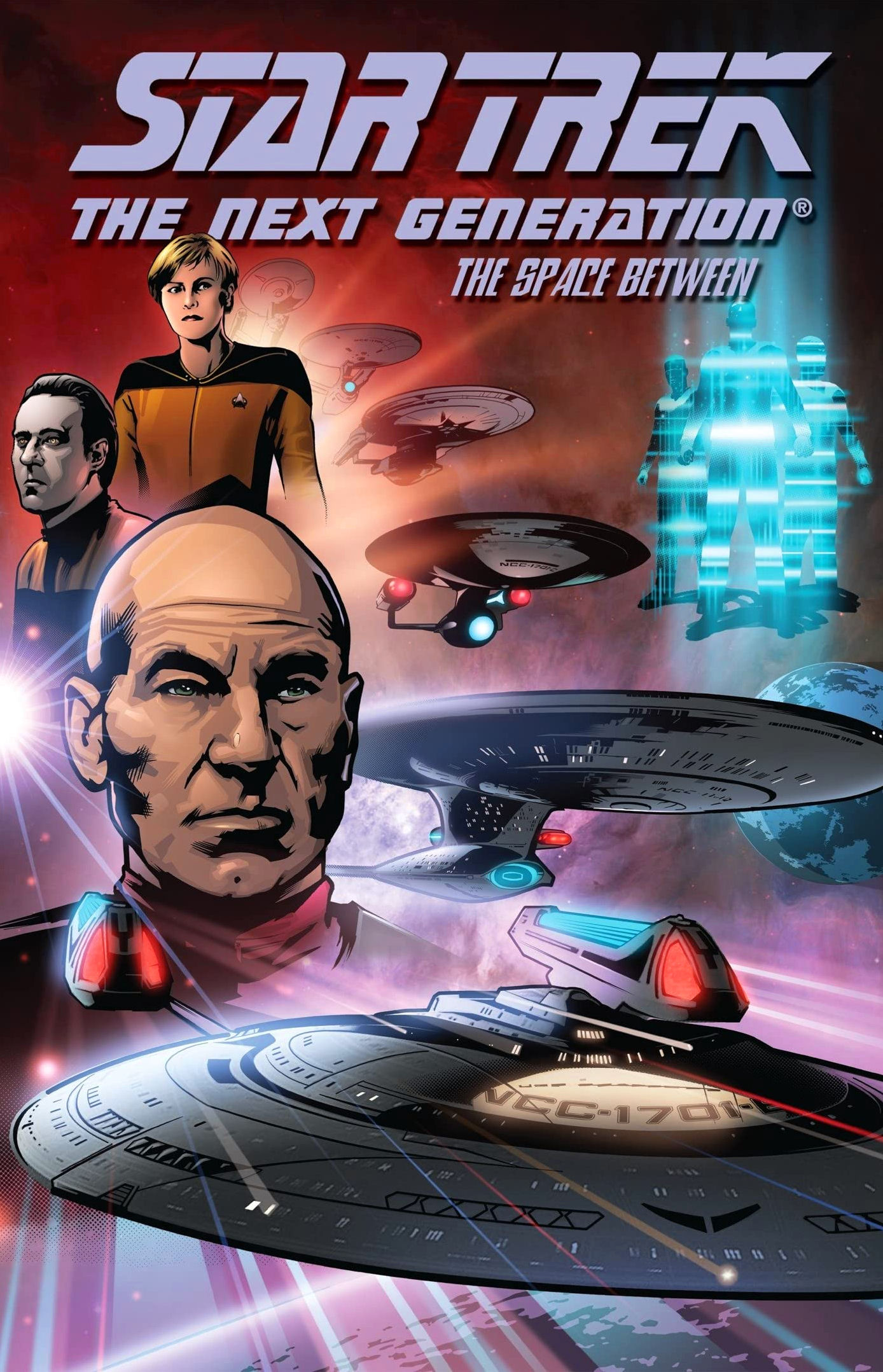 Story: A series of loosely connected adventures traces the Enterprise crew’s infrequent brushes with a slowly-unfolding mystery that points toward a shadow faction of Starfleet whose actions could endanger the Federation’s peaceful agenda.
Story: A series of loosely connected adventures traces the Enterprise crew’s infrequent brushes with a slowly-unfolding mystery that points toward a shadow faction of Starfleet whose actions could endanger the Federation’s peaceful agenda.
Review: Published in six issues in 2007 to commemorate the 20th anniversary of the launch of Star Trek: The Next Generation, “The Space Between”‘s six discrete stories are so tenuously connected that one could be forgiven for not realizing that there’s connecting tissue at all. But that’s not really a problem, since “The Space Between” also happens to consist of some pretty good stand-alone stories that feel absolutely authentic to the “eras” of TNG that they portray.
The first story, “History Lesson,” is a nifty little mind-bender that would’ve done Brannon Braga proud in the show’s later years of Mental Possession Plots Every Third Week, and yet this one seeems almost fresh, set during the first season with an interesting artistic take on the characters and Tasha Yar kicking ass like she seldom got to do on TV. “Captain’s Pleasure” builds on the notion of Picard taking leave from the big chair to go on archaeological digs (see also The Chase, Gambit part I), and as with the television episodes where that happened, there’s not only an archaeological mystery but a murder mystery to solve, along with the unlikely sight of Beverly Crusher getting down in a Studio 54-style holodeck disco.
“Strategy” fast-forwards to season 7 and, amid a plotline about recurring attacks by a mystery vessel possession Federation, Romulan and Borg tech, addresses the Worf-Troi-Riker love triangle more adeptly than the series ever got around to doing. “Light Of The Day” is an odd duck, almost like a Star Trek take on a zombie story – which, of course, IDW later did across all of its licensed ranges with its Infestation miniseries. With zombies about as overexposed in horror fiction as vampires are these days, this was the least interesting story to me, though it did at least bring Ensign Ro back into the fold (I’m guessing somewhere in season six, since no stardate is given), and features some fascinating visual effects for the view from Geordi’s VISOR.
The in-jokey title of “Space Seeds” (playing off of Space Seed, the original Trek episode that introduced Khan) is set during season 2, and features an interesting agricultural sci/tech mystery (yes, you read that right) in which Wesley Crusher plays a vital role (you read that right too) and even kicks butt (you’re still reading that right). It’s almost my favorite story in the book, with one exception: without the restriction of having to track down a specific actor or meet the approval of producers making a current Trek series, why no Doctor Pulaski?
The end of “Space Seeds” abruptly sets up the final story, “An Inconvenient Truth,” which would seem to be a TNG nod to Section 31 (a concept introduced in Deep Space Nine and later revealed to have been around as far back as  Star Trek: Enterprise). Admiral Nechayev is brought back and cast in a rather sinister light – we still don’t know whose side she’s on by the end of the story. (Maybe she doesn’t know either, explaining her eternal crankiness.)
Star Trek: Enterprise). Admiral Nechayev is brought back and cast in a rather sinister light – we still don’t know whose side she’s on by the end of the story. (Maybe she doesn’t know either, explaining her eternal crankiness.)
Writer David Tischman – who scripted all of the disparate adventures – betrays a little bit of love for the last Star Trek spinoff to hit TV to date; Picard’s archaeological team finds a long-lost Starfleet shuttlepod from the starship Columbia (NX-02), while “Strategy” revives the notion of Romulans deploying remote-controlled ships. The TNG characters are written pitch-perfect – perhaps too pitch-perfect, as there are a few places where I rolled my eyes at a couple of seemingly over-the-top characterizations before reminding myself that the TV series, a creature of the ’80s that just happened to live on into the ’90s, would likely have done exactly the same things. For good or ill, Tischman’s scripts evoke the series perfectly.
Casey Maloney’s artwork improves throughout the story cycle, though this may be a case of other inkers (Maloney draws and inks the early stories) bringing their own style to the table and enhancing his already impressive artwork. By the time the final story kicks in, it’s one of the best-looking Trek comics I’ve ever seen. And thank goodness for the lovely cover artwork on the trade paperback: the individual issues had three covers each – an “A” cover (usually very nicely done artwork), a “B” cover (always an execrable photo-montage of well-worn publcity shots) and retailer incentive covers, which zig-zagged between both styles. The cover on the TPB is the best of one world, thank you very much.
This was IDW’s first foray into the Next Generation license, and in many ways it’s still my favorite.
Year: 2007
Writer: David Tischman
Pencils: Casey Maloney
Inks: Casey Maloney, Aaron Leach, Stacie Ponder
Colors: Leonard O’Grady
Letters: Robbie Robbins, Neil Uyetake, Chris Mowry
Publisher: IDW
Pages: 144



